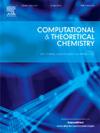环磺酰胺与环己基硼酸烷基化机理的DFT研究
IF 3
3区 化学
Q3 CHEMISTRY, PHYSICAL
引用次数: 0
摘要
采用M06-2×-D3/ma-def2-svp方法,以SMD模型为基础,在CH3CN溶剂中研究了环磺酰胺烷基化反应的机理。计算结果表明,环己基硼酸(R1)经过均解反应得到环己烷自由基(IM2),而环己烷自由基(IM2)可以通过加成反应得到产物衍生物。最后,两个可能的路径(a1和a2)可以帮助完成HAT(氢原子转移)过程以产生最终产品。吉布斯自由能表面显示a2路径是有利的。而TFA (CF3COOH)的加入则揭示了质子转移过程首先发生,质子化的环醛胺(R2)与IM2形成自由基中间体,该中间体有两种可能的途径(b1和b2)生成最终产物。吉布斯自由能谱表明,有利的过程是连续的质子转移和HAT反应。总之,有贸易便利化协定参与的路径是最有利的。结果将为这些类型的相互作用和相关的相互作用提供有价值的见解。本文章由计算机程序翻译,如有差异,请以英文原文为准。

Mechanism of CH alkylation of cyclic sulfonamides and Cyclohexylboronic acid: A DFT investigation
Mechanisms for the C![]() H alkylation of cyclic sulfonamides have been investigated with M06-2×-D3/ma-def2-svp method and basis set in the solvent of CH3CN with SMD model. The calculations suggest that cyclohexylboronic acid (R1) goes through homolysis process to obtain the cyclohexane radical (IM2), which can have an addition reaction to get product derivates. Finally, the two possible paths (a1 and a2) could help to finish the HAT (Hydrogen Atom Transfer) process to yield final product. Gibbs free energy surfaces show that path a2 is favorable. While the addition of TFA (CF3COOH) reveals that the proton transfer process would firstly occur and the protonated cyclic aldimine (R2) and IM2 formed a radical intermediate, which has two possible paths (b1 and b2) to yield the final product. Gibbs free energy profiles suggest that the favorable process is consecutive proton transfer and HAT reactions. All in all, the path with the participation of TFA is the most favorable. Results would provide valuable insights into these types of interactions and related ones.
H alkylation of cyclic sulfonamides have been investigated with M06-2×-D3/ma-def2-svp method and basis set in the solvent of CH3CN with SMD model. The calculations suggest that cyclohexylboronic acid (R1) goes through homolysis process to obtain the cyclohexane radical (IM2), which can have an addition reaction to get product derivates. Finally, the two possible paths (a1 and a2) could help to finish the HAT (Hydrogen Atom Transfer) process to yield final product. Gibbs free energy surfaces show that path a2 is favorable. While the addition of TFA (CF3COOH) reveals that the proton transfer process would firstly occur and the protonated cyclic aldimine (R2) and IM2 formed a radical intermediate, which has two possible paths (b1 and b2) to yield the final product. Gibbs free energy profiles suggest that the favorable process is consecutive proton transfer and HAT reactions. All in all, the path with the participation of TFA is the most favorable. Results would provide valuable insights into these types of interactions and related ones.
求助全文
通过发布文献求助,成功后即可免费获取论文全文。
去求助
来源期刊

Computational and Theoretical Chemistry
CHEMISTRY, PHYSICAL-
CiteScore
4.20
自引率
10.70%
发文量
331
审稿时长
31 days
期刊介绍:
Computational and Theoretical Chemistry publishes high quality, original reports of significance in computational and theoretical chemistry including those that deal with problems of structure, properties, energetics, weak interactions, reaction mechanisms, catalysis, and reaction rates involving atoms, molecules, clusters, surfaces, and bulk matter.
 求助内容:
求助内容: 应助结果提醒方式:
应助结果提醒方式:


